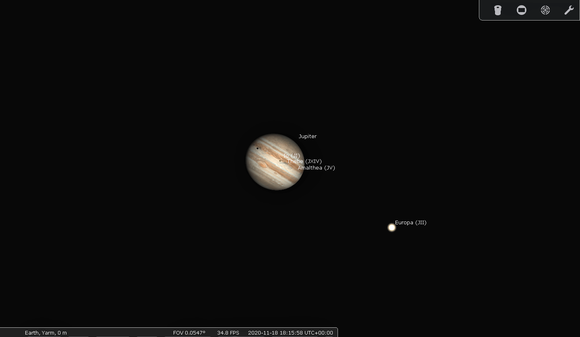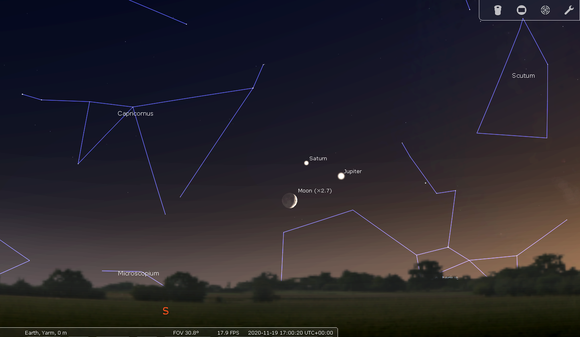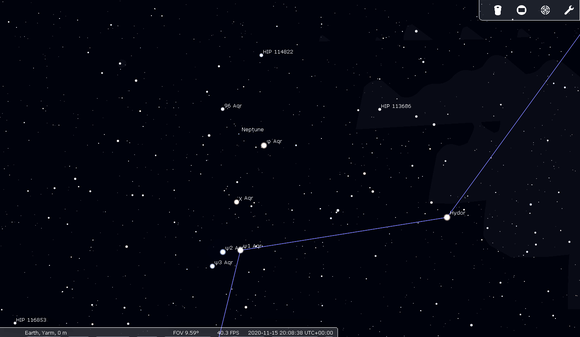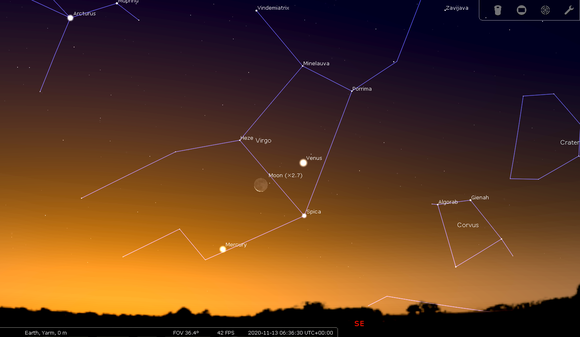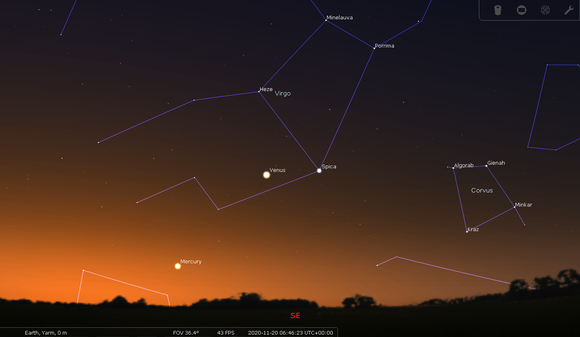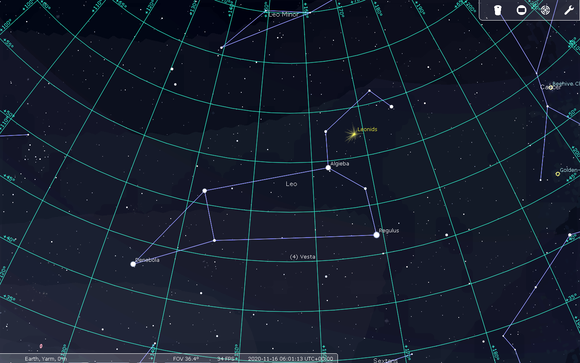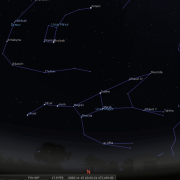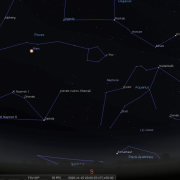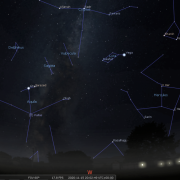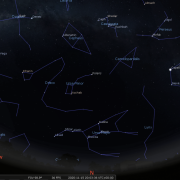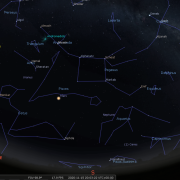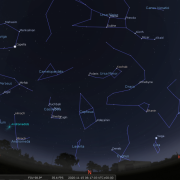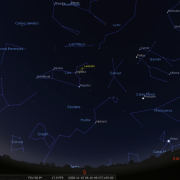Welcome to the WDAS monthly newsletter for November 2020: a digest of the month's latest contributions to our website. Below you'll find Society News: including Member photos and Sky Notes for the coming month.
Society News
Shock, horror! The planned 'Mars party' observation evenings at the Bruce Observatory on the 23rd and 30th actually went ahead, beating both the weather and Covid restrictions. Although sky conditions were less than ideal, they were good enough to allow some decent viewing with a window of opportunity (as forecast correctly by the Met Office -not BBC) falling just right. The event, organized by Mark, was 'bookable only' with half hour time slots for a maximum of five people per slot. On paper (excel spreadsheet to be precise) the system looked to be workable. In practice, it just about proved to be so, with only a few small teething issues encountered. Not least of these was the position of Mars as seen from the observatory, which as Keith and Mark found out to their dismay and annoyance just a few days before the first event, was still hidden by the tree line. Each time slot period therefore had to be delayed by 20 minutes to accommodate the growth of flora over the summer!
Friday was very much a mixed bag weather wise, but by late afternoon skies cleared somewhat, and having picked Keith up with Eviscope, we opened up the observatory and deployed Keith's Eviscope and Mark's 10 inch dobsonian outside. In total seven groups were booked in, starting from roughly 20:00h until 22:30h. Proceedings progressed fairly smoothly, everyone turned up more or less on time, face masks were worn by all and the two scopes outside manned by Keith, allowed people to view before and after they had been in the observatory with Mark. Views of Jupiter and Saturn setting in the SW were possible for the initial groups, but Mars was the main focus of our attention. 'Seeing' was a little turbulent, but improved somewhat as the evening wore on with some high thin cloud appearing.
Nearly all present had never been in, (or even seen) the Bruce Observatory before, so it came as a bit of a revelation that a 140 year old telescope could yield such good views, the long f ratio of the 5 inch Cooke refractor coming into its own. Everyone seemed to think the comparatively short period spent in the Observatory had been worth the (in quite a few cases) not inconsiderable journey time, and were appreciative of the effort we had made.
The following night (24th) was an overspill night, but had to be postponed due to bad weather, however as we had rearranged events for the Sunday evening, matters turned out well again with better 'seeing' and clearer skies.
The event on the 30th actually proved to be the best with regards to observing Mars itself. The forecast had been very tricky to read, but we correctly guessed a window of opportunity would allow observations for the duration of our time slots. The intermittent high cloud actually aided matters, acting as a natural filter, just dimming the image of Mars sufficiently to allow surface detail to be better resolved. Certainly the groups who attended were very pleased they had chanced it, with some exceptional views possible, which Keith thought were up there with the best he'd seen through the scope.
The event on the 31st we thought prudent to cancel due to forecast high winds, which can exert to much force on the observatory flaps and hinges. But as it turneed out cloud would have prevented observations anyway. All in all, our gamble had paid off. What lies ahead Covid restriction wise is even more difficult to forecast than the weather!
25_11_20 Image taken by member Richard Randle with i phone
thru' Cooke refractor using adaptor (click for larger image)
Suitably masked, people look thru' the eyepiece of the
Cooke refractor at Mars (click for full image)
Our planned schedule for NAW events is sadly in the bin, all cancelled due to the lockdown in England with no inter household mixing possible until at least early December. So, it's going to be a case of doing your own observing when conditions allow. National Astronomy Week runs from Nov 14th-Nov 21st, which is a 'no moon' period, and therefore would be ideal for tracing out fainter constellations or observing deep sky objects. If possible, if you can venture outside during NAW on an evening, even if it's just for half an hour in the back garden, or to a nearby darker location, (not one 20 miles away!) do so, and enjoy the beauty of the night sky.
If you are a complete novice and have never really tried stepping out under the stars before, even a humble pair of binoculars will reveal a plethora of star fields and objects that may 'wet' the appetite and send you scurrying to find out more, perhaps even leading to purchasing a telescope. More on this next month. If you are more experienced, perhaps try and make an effort to track down something new in the sky.
It's going to be a long and quite possibly, un-gregarious winter, gazing up and contemplating the 'bigger picture' may just be the tonic we are all going to need. And if you want to add a touch of gin to ward off the chill, that's fine by me!
 Not really surprising that we won't be able to hold society meetings in November, or quite probably December (but we'll see). So, it's looking as though it's going to be the New Year (not necessarily January either) before we have chance to meet formally at the College.
Not really surprising that we won't be able to hold society meetings in November, or quite probably December (but we'll see). So, it's looking as though it's going to be the New Year (not necessarily January either) before we have chance to meet formally at the College.
Open, or even just members evenings at the Bruce Observatory also look impossible for November and doubtful for December, but circumstances may change by then..or not.
Planning anything with regard to organizing a Christmas meal, is at this point in time, very much like the 'jugglers balls', - up in the air. If by any chance in December it becomes legal to do so, consideration will be given. Otherwise like everything else, it will have to wait until into the new year! March is going to be a hell of a month!
A great favourite with amateur astronomers up and down the land, Paul Money's excellent Night Scenes publication will be changing format for the 2021 edition due to financial viability because of the Covid 19 situation. The 2021 edition will not be available in the usual printed booklet form, but instead either as a pdf download format, or on Kindle.
The expected release date was going to be Nov 1st and therefore details of this and how to order and pay were not clear before these notes were completed. However once matters are clarified an update will be placed on the society web site. Paul has stated he would very much like the 2022 edition to back as a full colour booklet again. So say all of us!
Sky Notes
In this month's Sky Notes:
Planetary Skylights - Brief
Mars now holds centre stage and for anyone with a half decent telescope, the Red planet should be your first port of call to view through the eyepiece. Actually, make that second or even third, because if you still want to take a peek at Jupiter and Saturn, they should be your first targets, located as they are low in SW sky and available for scrutiny for a limited time only before setting. At the start of November this will be around 20:00 GMT for Jupiter, with Saturn following 30mins later. By the end of the month it’s around 18:30 GMT when they depart.
 Jupiter remains conspicuous to the eye, and given steady seeing (which as it drops lower to the horizon becomes ever more erratic), there is still plenty to admire and scrutinize. The Great Red Spot (GRS) for instance appears to have stopped shrinking and turned far redder. It used to be three times the size it is now in the 1800’s. There are also a number of other storm features brewing, one immediately below the GRS and another on the North tropical zone band. So even though Jupiter is nearing the end of its apparition it’s worth observing to keep tabs on to compare with any changes that may occur before it reappears in the dawn sky early next year. The daily dance of the Galilean moons is also fascinating to watch, especially if there are shadow transits.
Jupiter remains conspicuous to the eye, and given steady seeing (which as it drops lower to the horizon becomes ever more erratic), there is still plenty to admire and scrutinize. The Great Red Spot (GRS) for instance appears to have stopped shrinking and turned far redder. It used to be three times the size it is now in the 1800’s. There are also a number of other storm features brewing, one immediately below the GRS and another on the North tropical zone band. So even though Jupiter is nearing the end of its apparition it’s worth observing to keep tabs on to compare with any changes that may occur before it reappears in the dawn sky early next year. The daily dance of the Galilean moons is also fascinating to watch, especially if there are shadow transits.
Jupiter GRS and Galilean moon shadow transit visibility:
-
1st - GRS visible 17:30h GMT(UT) until Jupiter sets
-
3rd - Callisto shadow transit visible before 16:50- 17:40h GMT
-
5th - GRS visible from 17:00- 19:00h GMT
-
8th - GRS visible from 18:00h GMT until Jupiter sets.
-
11th - GRS and Io shadow transit from 18:00h - 17:15h GMT
-
13th - GRS visible pre 17:00h GMT until Jupiter sets.
-
16th - GRS visible from 16:45h until 17:40h GMT
-
18th - GRS visible from 16:30h until 19:00h GMT and Io shadow transit from 18:00h GMT
-
20th - GRS visible from 17:00h GMT until Jupiter sets
-
23rd - GRS visible from 16:30-17:45h GMT
-
25th - GRS and Europa shadow transit visible from 17:00h - 17:30h GMT
-
28th - GRS visible from 16:30h GMT until sets
-
30th - GRS and Ganymede shadow transit visible from 16:30h until 18:00h GMT
 Saturn trails a short distance behind Jupiter and is much less conspicuous, but still readily visible to the naked eye. Binoculars (unless very powerful) fail to reveal the beautiful ring system, but even a very modest telescope will show that the rings are still well orientated with respect to Earth. Look also for Titan, Saturn’s largest moon, it will resemble a ‘bright speck’ nearby Saturn. Again, because of the low altitude of Saturn, to give yourself the best opportunity of 'semi decent' seeing, view early in the month and early in the evening. The moon passes by Jupiter and Saturn on the 19th. By the end of the month Jupiter is noticeably edging toward Saturn, closing to half the distance it started at the beginning of November. This continues into December leading to an end of year finale that will cause quite a stir, and will be one of the observing highlights of 2020! All we need are 3 wise men and 3 kings!
Saturn trails a short distance behind Jupiter and is much less conspicuous, but still readily visible to the naked eye. Binoculars (unless very powerful) fail to reveal the beautiful ring system, but even a very modest telescope will show that the rings are still well orientated with respect to Earth. Look also for Titan, Saturn’s largest moon, it will resemble a ‘bright speck’ nearby Saturn. Again, because of the low altitude of Saturn, to give yourself the best opportunity of 'semi decent' seeing, view early in the month and early in the evening. The moon passes by Jupiter and Saturn on the 19th. By the end of the month Jupiter is noticeably edging toward Saturn, closing to half the distance it started at the beginning of November. This continues into December leading to an end of year finale that will cause quite a stir, and will be one of the observing highlights of 2020! All we need are 3 wise men and 3 kings!
 And so to Mars, which could wait a few hours after all, not crossing the southern meridian until later in the evening, and residing much higher in the sky than Jupiter and Saturn ever did this year. As we head into November, Mars will still look the most dominant planet to the naked eye in the night sky, its soft fiery glow dominating the SE-S aspect at magnitude -2.1. By the month’s end however, Mars will have diminished quite markedly in intensity, to mag -1.2, its disk size will also have shrunk from 20 arc seconds to 14.5 arc seconds. If you can then, view Mars early in the month.
And so to Mars, which could wait a few hours after all, not crossing the southern meridian until later in the evening, and residing much higher in the sky than Jupiter and Saturn ever did this year. As we head into November, Mars will still look the most dominant planet to the naked eye in the night sky, its soft fiery glow dominating the SE-S aspect at magnitude -2.1. By the month’s end however, Mars will have diminished quite markedly in intensity, to mag -1.2, its disk size will also have shrunk from 20 arc seconds to 14.5 arc seconds. If you can then, view Mars early in the month.
Through binoculars, Mars is a bit of a disappointment, a very small orange dot. It has to be said that on many occasions it isn’t much better in a telescope either, usually to do with ‘seeing’, ie our turbulent atmosphere, or dust storms on Mars itself. People’s perceptions of what to expect in the eyepiece are also sometimes rather misguided. The Martian disk will certainly not fill the eyepiece (at least for most observers). Mars is a smallish world, considerably smaller than Earth, and only at favourable oppositions does it appear reasonably ‘less small’ so that surface detail can be made out. And it is the surface you will be peering at, not atmosphere or cloud, the actual surface of another world. Well hopefully it will be, as Mars can sometimes be engulfed in huge dust storms which turn the disk a featureless pinky/orange hue. For UK observers Mars is now at its best opposition until 2035, pretty high in the night sky in Pisces and so far, free from dust storms, (as of writing). The moon lies below Mars on the 25th.
 Uranus is now well placed to track down in the evening sky, residing just within the borders of Aries, approximately 10 degrees below the ‘crooked line’ asterism of the Ram marked by Hamal and Sheratan and Mesatim. Although not a naked eye object for the majority of people, at mag +5.7 Uranus is borderline naked eye for keen sighted observers viewing from dark viewing locations (assuming they know exactly where to look). Uranus can be located just over a degree west of the faint 6th mag star 29 Ari. Through binoculars Uranus resembles a rather faint star of subtle grey/green hue. You will require a telescope (modest size upwards) to discern its tiny disk, which appears to have a slightly ghoulish hue to it, at least to my eyes.
Uranus is now well placed to track down in the evening sky, residing just within the borders of Aries, approximately 10 degrees below the ‘crooked line’ asterism of the Ram marked by Hamal and Sheratan and Mesatim. Although not a naked eye object for the majority of people, at mag +5.7 Uranus is borderline naked eye for keen sighted observers viewing from dark viewing locations (assuming they know exactly where to look). Uranus can be located just over a degree west of the faint 6th mag star 29 Ari. Through binoculars Uranus resembles a rather faint star of subtle grey/green hue. You will require a telescope (modest size upwards) to discern its tiny disk, which appears to have a slightly ghoulish hue to it, at least to my eyes.
 Neptune resides in the constellation of Aquarius, just over 2 degrees north-east of the star Phi aqr (mag +4.2), whilst 96 aqr. (mag+5.5) lies 42 arc minutes to the WNW of it. You will definitely require a telescope to spot the diminutive disk, which has a blue/grey hue and using higher magnification will help. Binoculars only show it as a speck; again, assuming you know exactly where to look.
Neptune resides in the constellation of Aquarius, just over 2 degrees north-east of the star Phi aqr (mag +4.2), whilst 96 aqr. (mag+5.5) lies 42 arc minutes to the WNW of it. You will definitely require a telescope to spot the diminutive disk, which has a blue/grey hue and using higher magnification will help. Binoculars only show it as a speck; again, assuming you know exactly where to look.
Dawn Planets
 In the dawn sky Venus reins supreme, a brilliant beacon of mag - 4.1 above the ESE horizon. Over the course of November Venus slides back toward the horizon, passing the chief star in Virgo – Spica, which along with all the other stars in the eastern dawn sky heading the other way. Venus and Spica appear closest on the 17th. Unlike Mars, Venus’s surface is perpetually hidden by cloud and the view thru the eyepiece is rather bland. You will however observe the phase – which is a 88% gibbous.
In the dawn sky Venus reins supreme, a brilliant beacon of mag - 4.1 above the ESE horizon. Over the course of November Venus slides back toward the horizon, passing the chief star in Virgo – Spica, which along with all the other stars in the eastern dawn sky heading the other way. Venus and Spica appear closest on the 17th. Unlike Mars, Venus’s surface is perpetually hidden by cloud and the view thru the eyepiece is rather bland. You will however observe the phase – which is a 88% gibbous.
 Venus is not the only planet in the dawn sky, with Mercury putting on its best morning apparition this year. The elusive world is visible from the start of the month where it resides to the left of Spica. By the 10th it has gained in altitude to almost 12 degrees above the SE horizon, reaching greatest western elongation from the Sun, some 19 degrees. Mercury will then arc back toward the SE horizon, actually gaining in brightness as it does so. To observe Mercury, look for another ‘fairly bright star’ lower left of Spica at the start of November. At mag + 1.4 Mercury will appear slightly fainter than Spica. However, if possible view on the 13th around 6am, when Mercury, Spica, the Moon and Venus form a diamond pattern, a highlight this month certainly. Mercury will have brightened to mag -0.7 by then. By the end of the month Mercury will be around mag -1.0 but very low down. A clear SE horizon aspect is required. Use binoculars to help out initially. A telescope at high power will reveal a phase only; crescent at the start of November and gibbous by the end.
Venus is not the only planet in the dawn sky, with Mercury putting on its best morning apparition this year. The elusive world is visible from the start of the month where it resides to the left of Spica. By the 10th it has gained in altitude to almost 12 degrees above the SE horizon, reaching greatest western elongation from the Sun, some 19 degrees. Mercury will then arc back toward the SE horizon, actually gaining in brightness as it does so. To observe Mercury, look for another ‘fairly bright star’ lower left of Spica at the start of November. At mag + 1.4 Mercury will appear slightly fainter than Spica. However, if possible view on the 13th around 6am, when Mercury, Spica, the Moon and Venus form a diamond pattern, a highlight this month certainly. Mercury will have brightened to mag -0.7 by then. By the end of the month Mercury will be around mag -1.0 but very low down. A clear SE horizon aspect is required. Use binoculars to help out initially. A telescope at high power will reveal a phase only; crescent at the start of November and gibbous by the end.
13-Nov-2020 at 06:30h (E): Conjunction of Venus, Moon, Spica and Mercury
(Click for full-sized image)
Meteors

The Leonids are active from Nov 15-20th with this year’s peak over the night of the 17/18th. Conditions should be excellent with a New Moon just a few days before. In most years Leonid rates are around 25 per hour, rising to 100’s if not 1000’s during ‘storm’ years, which occur at intervals of roughly 33 years, coinciding with the return of the periodic parent comet Temple Tuttle. The next expected storm event will be sometime after 2030, but there is a possibility of some enhanced activity this year from a debris stream in the early morning hours of the 18th. We won’t know for definite until then. Leonids are very swift in nature often leaving trails. Should you be up and about and it is clear certainly keep a watch.
Also during November keep an eye out for a few meteors on the night of Nov 4/5th when the South Taurid meteor shower reaches a peak, and then again on the night of Nov 11/12 when the North Taurid meteor shower peaks. The hourly rate is low; only around 5 meteors, but although few, Taurids can produce a few fireballs! The Taurids are an old shower, associated with the periodic Comet Enke. Over time dust from this comet has been depleted and spread out over a broad swath of the inner solar system, giving rise to Taurid meteor showers not only on Earth but also on Mars and Venus. A moon will interfere markedly for the South Taurid shower, but much less so for North Taurids.
Vesta in Leo
If you fancy an intriguing challenge, try spotting the minor planet, Vesta in the dawn sky between Nov 15th and 17th. It lies just below Leo, which will be high to the south at 06:00GMT. At mag +8 you will require a small telescope to really appreciate the vista, but large binoculars may also suffice. Over the course of the 3 mornings, Vesta will pass between the galaxies M95 and M96, its presence therefore quite obvious. On the 15th it will lie upper left of M95 and a day later just below M96. Both galaxies are visible with a small telescope.
16-Nov -2020 at 06:00h (S): Detailed chart for Vesta splitting
M95 and M96 in Leo (Click for full-sized image)
November 2020 Sky Charts
Additional Image Credits:
- Planets and Comets where not otherwise mentioned: NASA
- Sky Charts: Stellarium Software





